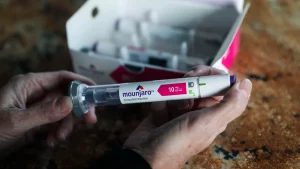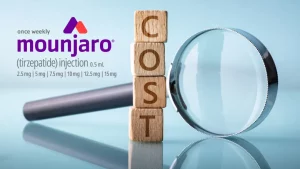How to get Mounjaro for Weight Loss?- A Comprehensive guide 2023
Introduction to Mounjaro
Are you struggling to lose weight despite trying various diets and exercise routines? If so, you may be interested in Mounjaro, an innovative weight reduction treatment that is making waves in the world of health and wellbeing.
Mounjaro is a dietary supplement for weight loss that is known as a natural and risk-free solution to assist both women and men in achieving their goals regarding their weight.
In this article, we will look into the Mounjaro treatment and investigate the possible advantages it may have for weight reduction. We’ll also go over how it works for weight loss and who is considered to be the right candidate for this type of treatment.
What is Mounjaro?

Before we dive into how this treatment works for weight loss, let’s quickly go over what Mounjaro is. Mounjaro is an injectable medicine that contains Tirzepatide, also known by its generic name. It is the most recent advancement in the management of type II diabetes and obesity. However, both women and men have been utilizing this treatment to manage and promote weight loss while accompanying it with a proper diet and good physical activity on a daily basis.
Mounjaro Variants: Different Mounjaro Doses Available
Here are the different types of doses of Mounjaro:
The starting dose of Mounjaro is 2.5 mg, taken once weekly.
After 4 weeks, the dose is increased to 5 mg.
Mounjaro is available in six strengths ranging from 2.5 mg to 15 mg.
If additional glycemic control is needed, the dose can be increased by 2.5-mg increments after at least 4 weeks on the current dose.
The maximum dose of Mounjaro is 15 mg once weekly.
It is important to note that the dose of Mounjaro prescribed by a healthcare provider may vary depending on the individual’s specific needs and medical history.
It is also important to speak with your healthcare provider to determine the best course of action for your specific situation.

Who Makes Mounjaro?
Mounjaro is made by Eli Lilly and Company, a global pharmaceutical company headquartered in Indianapolis, Indiana. Eli Lilly and Company is a leading developer of innovative medicines and has been in operation for over 140 years. Mounjaro is their most recent advancement in the management of type 2 diabetes and obesity.
Is Mounjaro FDA approved for Weight loss?
Mounjaro is not currently FDA-approved for weight loss. However, the manufacturer of Mounjaro, Eli Lilly is seeking FDA approval for the drug to be covered for weight management, and the FDA is expected to review and potentially approve it for this use in late 2023.
Mounjaro is currently only approved to improve blood glucose levels in adults with type 2 diabetes.
However, it is important to note that off-label use of medications should only be done under the guidance of a healthcare professional. It is advisable to speak with your healthcare provider to determine the best course of action for your specific situation.
How to get Mounjaro for Weight Loss?
Mounjaro can be acquired through various means, including online platforms, through a doctor’s prescription, or utilizing insurance.
It is important to note that Mounjaro prescription medication should only be taken under the guidance of a healthcare professional.
The doctor will decide on the appropriate Mounjaro dosage and frequency of Mounjaro injections.
How to inject Mounjaro?

Here are the steps to follow when injecting Mounjaro:
- Choose your Mounjaro injection site: Mounjaro can be injected into the thigh, abdomen, or back of the upper arm. It is recommended to rotate injection sites each week to minimize any potential skin irritation or discomfort.
- Pull off the gray base cap: Before administering the injection, remove the gray base cap from the pen.
- Clean the injection site: Clean the injection site with an alcohol swab and let it dry.
- Inject the medication: Place the clear base flat against your skin in the area you plan to inject. Twist the lock ring to the unlock position, then press and hold the purple injection button.
- Click: You’ll hear the first click which means the injection has started followed by a second click to indicate the injection is complete.
- Hold the Button: After hearing the second click, it is generally recommended to continue to hold the button while you count to six before releasing the button and removing the pen from the skin.
This ensures you have received the full amount of the medication. - Wait: In total, generally the injection takes approximately 10 seconds to complete.
- Dispose of the pen: After the injection is complete, dispose of the pen in a sharps container.
It is important to note that Mounjaro should never be injected into a vein or artery, and it should not be injected into lean or mostly muscular parts of the body. These injections tend to be painful, may bleed more than normal, and can cause the medication to be less effective.
It is also important to speak with your healthcare provider to determine the best injection site and technique for you.
How does Mounjaro work?
The Mechanism of Mounjaro in Weight Loss:
Mounjaro has a type of drug called a glucose-dependent insulinotropic polypeptide (GIP) and glucagon-like peptide-1 (GLP-1) receptor agonist.
It works by mimicking the activity of the hormones GIP and GLP-1. Mounjaro promotes weight loss by improving satiety, breaking down fat, and reducing sugar cravings.
It facilitates weight loss by reducing the rate at which food is processed by your digestive system, which is also known as a prompt gastric emptying.

Impact on Blood Sugar Levels:
Mounjaro has been shown to have a positive impact on blood sugar levels, making it an effective treatment for type II diabetes. Clinical trials of Mounjaro for treating type 2 diabetes looked at the drug’s effect on body weight. Many people who used the drug for type 2 diabetes did lose weight. However, these trials did not specifically look at Mounjaro as a weight loss medication.
Weight Loss Outcomes:
Clinical trials have shown that Mounjaro is more effective than Ozempic for weight loss, with patients achieving 26.6% weight loss over 84 weeks.
It is important to note that individual results may vary, and weight loss outcomes depend on various factors such as diet, exercise routine, and overall health

A separate clinical trial looked at the use of Mounjaro for weight loss in people without diabetes.
The trial included adults with either obesity (body mass index [BMI] of 30 or greater) or overweight (BMI of 27 or greater) and at least one health condition related to weight, such as high cholesterol, high blood pressure, or sleep apnea. Most adults in this trial lost at least 10% of their body weight after using Mounjaro for 72 weeks (about 18 months).
However, It is important to note that Mounjaro is not a substitute for a healthy diet and exercise routine, but rather a supplement to aid in weight loss.
The Cost Aspect of Mounjaro:
The Mounjaro cost with and without insurance coverage.
Mounjaro patient assistance programs are also available to help eligible patients afford the medication.

For People with insurance
Insurance Coverage may be eligible for the Mounjaro Savings Card program that helps people save money on their prescription.
To be eligible for this program, a person must have commercial insurance that covers Mounjaro and a prescription consistent with FDA-approved product labeling.
Mounjaro Savings Card: The Mounjaro Savings Card is a program offered by Eli Lilly, the manufacturer of Mounjaro. Eligible commercially insured patients may pay as little as $25 for a 1-month, 2-month, or 3-month prescription fill of Mounjaro.
The card is not available to government beneficiaries, and terms and conditions apply.
The card expires and savings end on 12/31/2023.
For People without insurance
Mounjaro is a prescription medication that can be quite expensive without insurance. However, there are ways to save money on Mounjaro, including utilizing coupons and savings programs. Here are some ways to save on Mounjaro:
- NiceRx: NiceRx offers Mounjaro for $49 per month, with or without insurance. They believe that medications should be affordable for everyone.
- GoodRx: GoodRx offers free coupons for Mounjaro, which can lower the price to as little as $991.16 per month, a savings of 15% off the retail price.
- ScriptSave WellRx: ScriptSave WellRx offers a free Mounjaro coupon that can be used at your local pharmacy. The discount range will vary depending on the type of prescription and the pharmacy chosen.
It is important to note that these savings programs and Mounjaro coupons have eligibility criteria and terms and conditions that must be met. It is also important to speak with your healthcare provider to determine if Mounjaro is the right treatment for you. Individuals who use Mounjaro long term may consider buying 90-day supplies to save money. They may discuss their options with a pharmacist or doctor.
People must contact their insurance provider to see whether their plan will cover Mounjaro.
How to store Mounjaro?
According to the Mounjaro Instructions for Use, Mounjaro should be stored in the refrigerator between 36°F to 46°F (2°C to 8°C). However, Mounjaro can be stored at room temperature up to 86°F (30°C) for up to 21 days.
It is important to note that Mounjaro should not be frozen, and it should not be stored near the cooling unit inside the fridge, as this could cause the medication to freeze. After 21 days, the medication inside the pen may start to spoil and may not be safe for use anymore.
It is important to dispose of any pen that has been out of the fridge for more than 21 days. It is also important to speak with your healthcare provider to determine the best storage and handling practices for your specific situation.
Mounjaro vs Other Weight loss Medications

Mounjaro vs Ozempic
Ozempic and Mounjaro are both prescription medications used to treat type 2 diabetes and aid in weight loss.They belong to the GLP-1 class of drugs and are both injectable medicines.
Mounjaro is the most recent advancement in the management of type 2 diabetes and obesity, and it contains Tirzepatide as its active ingredient.
On the other hand, Ozempic uses Semaglutide as its active ingredient.
In studies, Mounjaro was found to be more effective than Ozempic for blood sugar control and weight loss.
Mounjaro is slightly more expensive than Ozempic, and it is important to note that both medications have similar side effects, with Mounjaro potentially having more severe side effects.
Ultimately, the choice between Ozempic vs Mounjaro depends on the individual’s specific needs and the recommendation of their healthcare provider.
Mounjaro vs Wegovy
Wegovy, Ozempic, and Mounjaro are all injectable medications that can be used to treat type 2 diabetes and aid in weight loss. Here are the key differences between Wegovy and Mounjaro:
- FDA-approved uses: Mounjaro is currently only approved for the treatment of type 2 diabetes in adults, while Wegovy is approved for chronic weight management in adults and adolescents ages 12 and older.
- Weight loss outcomes: Both Mounjaro and Wegovy can cause significant weight loss. Mounjaro seems to cause more weight loss than Wegovy, but studies comparing the two directly are needed to confirm this.
- Side effects: Both medications have similar side effects, with Mounjaro potentially having more severe side effects.
- Cost: Mounjaro is slightly more expensive than Wegovy.
- Availability: Mounjaro is not yet approved for weight loss, but the FDA is expected to review and potentially approve it for this use in late 2023. Wegovy is already approved for weight loss.
It is important to note that these medications should only be taken under the guidance of a healthcare professional. The choice between Wegovy vs Mounjaro depends on the individual’s specific needs and the recommendation of their healthcare provider.
Mounjaro vs Trulicity
Mounjaro and Trulicity are both injectable medications used to treat type 2 diabetes and aid in weight loss. Here are the key differences between Mounjaro and Trulicity:
- Active ingredients: Mounjaro contains tirzepatide, which is a dual GIP/GLP-1 receptor agonist, while Trulicity contains dulaglutide, which is a GLP-1 receptor agonist.
- Mechanism of action: Mounjaro activates both the GLP-1 receptor and the glucose-dependent insulinotropic polypeptide (GIP) receptor, while Trulicity only activates the GLP-1 receptor.
- FDA-approved uses: Mounjaro is currently only approved to improve blood glucose levels in people with type 2 diabetes, while Trulicity is also FDA-approved to reduce the risk of heart disease in people with type 2 diabetes.
- Weight loss outcomes: Both medications can cause significant weight loss, but Mounjaro seems to cause more weight loss than Trulicity.
- Side effects: Both medications have similar side effects, but Mounjaro potentially has more severe side effects.
- Cost: Mounjaro is slightly more expensive than Trulicity.
It is important to note that these medications should only be taken under the guidance of a healthcare professional.
The choice between Trulicity vs Mounjaro depends on the individual’s specific needs and the recommendation of their healthcare provider.
Real-world Applications and Testimonials:
Mounjaro has gained popularity for its ability to promote weight loss by suppressing appetite and promoting lasting satiety.
Many people have shared success stories and professional recommendations about Mounjaro for weight loss.
However, it is important to note that Mounjaro is a prescription medication and should only be taken under the supervision of a healthcare provider.
Mounjaro Weight loss Before and After pictures


Safety and Side Effects:
Mounjaro has similar side effects to Ozempic, including nausea, vomiting, abdominal pain, and constipation.
It has been shown to develop thyroid tumors in rats, and the FDA advises against prescribing these drugs to those with a history of thyroid cancer in their family.
It is crucial to consider the possible side effects and interactions with other medications and substances before taking Mounjaro for weight loss.

You are encouraged to report negative side effects of prescription drugs to the FDA.
Visit www.fda.gov/medwatch or call 1-800-FDA-1088.
What happens when you stop taking Mounjaro?
According to our research, there is not much information available on what happens when you stop taking Mounjaro.
However, it is known that Mounjaro acts on GIP and GLP-1 receptors, which helps your body manage glucose more efficiently. Since it works to lower blood sugar, stopping Mounjaro carries the risk of glucose levels spiking back to their original levels.
Mounjaro also reduces appetite, so going off the drug may stimulate your appetite and cause you to eat more or indulge in foods you usually steer clear of, resulting in potential blood sugar spikes.
It is important to note that Stopping Mounjaro may result in weight gain, and an increase in appetite. It is advisable to speak with your healthcare provider before stopping Mounjaro to determine the best course of action.

Conclusion:
Mounjaro is a prescription medication that has been found to trigger significant weight loss in people who inject it. It is important to acquire Mounjaro through a doctor’s prescription and to consider the possible side effects and interactions with other medications and substances before taking it for weight loss.
Additionally, it is crucial to consider the cost of Mounjaro with and without insurance coverage. People who use Mounjaro long term may consider buying 90-day supplies to save money. Finally, it is important to note that Mounjaro should only be taken under the supervision of a healthcare provider.
Frequently Asked Questions (FAQs)
- What is Mounjaro?
Mounjaro is an injectable medicine that contains tirzepatide, also known by its generic name. It is the most recent advancement in the management of type II diabetes and obesity. - How does Mounjaro work for weight loss?
A: Mounjaro promotes weight loss by improving satiety, breaking down fat, and reducing sugar cravings. It facilitates weight loss by reducing the rate at which food is processed by your digestive system, which is also known as a prompt gastric emptying. - What are the possible side effects of Mounjaro?
Mounjaro has similar side effects to Ozempic, including nausea, vomiting, abdominal pain, and constipation. - Is Mounjaro covered by insurance?
Many insurance plans cover the cost of Mounjaro. It is important to check with your insurance provider to see if Mounjaro is covered under your plan. - Is Mounjaro a substitute for a healthy diet and exercise routine?
No, Mounjaro is not a substitute for a healthy diet and exercise routine, but rather a supplement to aid in weight loss. - How long can Mounjaro be out of the fridge?
Mounjaro should be stored in the refrigerator between 36°F to 46°F (2°C to 8°C). However, Mounjaro can be stored at room temperature up to 86°F (30°C) for up to 21 days. - What is Mounjaro $25 coupon?
The Mounjaro $25 coupon is a savings program offered by Eli Lilly, the manufacturer of Mounjaro. Eligible commercially insured patients may pay as little as $25 for a 1-month or 3-month prescription fill of Mounjaro
- Is Mounjaro Insulin?
Mounjaro is not insulin. Mounjaro is an injectable prescription medication used to improve blood sugar (glucose) levels in adults with type 2 diabetes mellitus. It is a dual GIP/GLP-1 receptor agonist that works differently than other type 2 diabetes medications by directly activating GIP and GLP-1 pathways to help regulate blood sugar. Mounjaro enhances both first and second phase insulin secretion, reduces glucagon levels, improves insulin sensitivity, decreases food intake, and slows gastric emptying.
It is important to note that Mounjaro is not for use in people with type 1 diabetes. - How long does Mounjaro stay in your system?
If you stop taking Mounjaro, it should be gone from your body in about 30 days.
For those who seek to delve deeper into the world of health, weightloss, wellness, and technological advancements in the health field, we extend an invitation to explore Espanol Health. A platform where the essence of health meets the vitality of knowledge, offering a plethora of informative blogs and articles that span across various health domains, including health tech and services provided.



